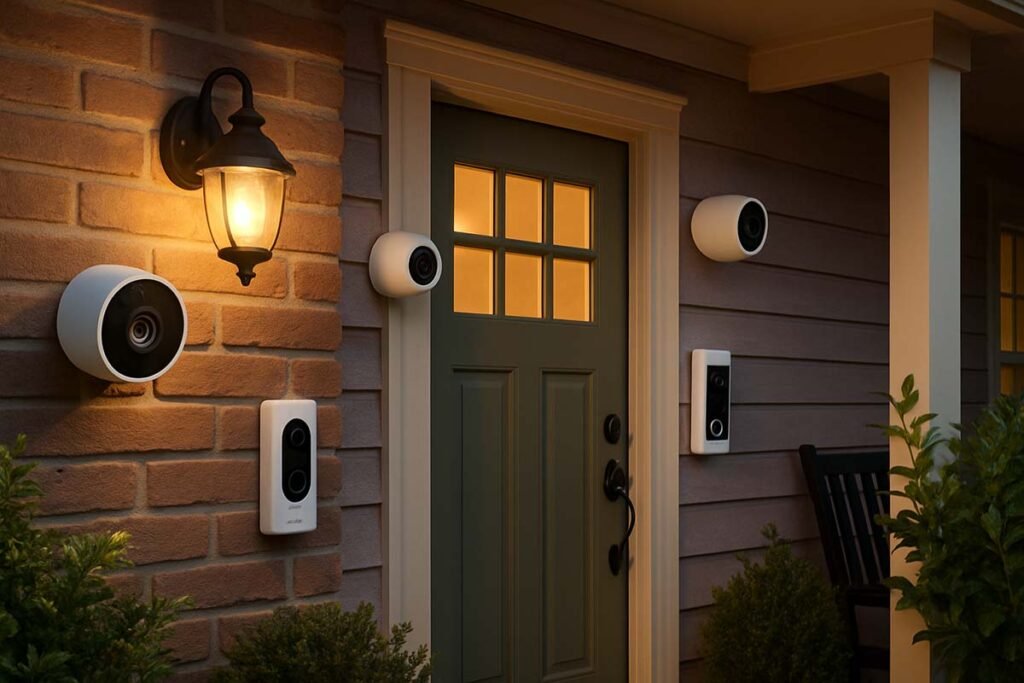Imagine walking into a home that knows when you’re cold and adjusts the thermostat automatically, or a kitchen that reminds you when you’re running out of milk. Across the United States, smart homes powered by AI are no longer just futuristic dreams—they’re everyday realities for millions of Americans. With the rapid rise of connected devices, homeowners are seeking gadgets that offer true value: convenience, security, and cost savings.
But with an overwhelming number of products on the market, how can savvy consumers know which smart home devices are truly worth their investment in 2025? In this comprehensive guide, we’ll explore the top AI-powered gadgets transforming American homes—from coast to coast—examine their unique features, and share real-world insights on how these devices make life easier and more economical. Whether you’re in a downtown apartment in Chicago or a suburban house in Texas, discover how smart tech can enhance your daily living and save you money.
Understanding the AI Smart Home Ecosystem
Smart homes are powered by a network of connected devices that communicate via AI algorithms to make your living space more intuitive. In the US, these ecosystems commonly include thermostats, lighting, security, entertainment, and kitchen appliances, all managed either through centralized hubs or voice assistants like Amazon Alexa, Google Assistant, or Apple Siri.
How AI Powers Smart Homes
- Learning user preferences: AI adjusts settings based on your habits.
- Predictive actions: Systems anticipate needs, e.g., pre-heating the oven.
- Real-time adaptations: Adjusting lighting and temperature responding to occupancy and weather.
- Inter-device communication: Seamlessly linking gadgets to work together.
This synergy transforms passive technology into active home assistants, saving time and improving comfort.
Top Smart Thermostats for Energy Efficiency and Comfort
Saving energy and controlling home temperature remotely top most American homeowner wishlists.
Market Leaders:
- Nest Learning Thermostat:
Uses learning algorithms to automatically adjust based on routines and can cut energy bills by up to 15%. Perfect for both urban high-rises and sprawling suburban homes. - Ecobee SmartThermostat:
Features multiple smart sensors that detect individual room occupancy, optimizing climate control room by room. - Honeywell Home T9:
Offers geofencing to adjust settings when you leave or return home, ideal for busy professionals in large cities.
Comparison Table: Features and Pricing
| Thermostat | Price | Unique Feature | US Smart Home Integration |
|---|---|---|---|
| Nest Learning | $249 | Learning algorithm | Google Assistant, Alexa |
| Ecobee SmartThermostat | $249 | Room sensors for multi-zone | Apple HomeKit, Alexa, Google |
| Honeywell T9 | $199 | Geofencing | Alexa, Google |
AI-Enhanced Security Systems to Protect Your Family and Property
Security remains top priority. AI-powered cameras and sensors offer smart detection, reducing false alarms.
Popular Options:
- Ring Video Doorbell Pro 2:
AI distinguishes people, packages, and vehicles, notifying you instantly through high-res video. - Arlo Ultra 4K Wire-Free Security Cameras:
Features color night vision and AI-based activity zones to focus on critical areas. - Nest Secure:
Integrates with Google’s ecosystem, offering facial recognition and automatic alerts for unusual activity.
Real-life anecdote: In 2025, a family in Miami reported that Ring’s AI detected a doorstep thief before a physical alarm ever sounded, allowing police intervention with zero loss.
Convenience and Control: Voice Assistants and Hubs
Voice assistants centralize command over your smart home devices.
Leading Tech:
- Amazon Echo Show (4th Gen):
Combines visual elements with Alexa’s AI to control smart devices, make video calls, or check daily schedules. - Google Nest Hub Max:
Uses facial recognition and gesture control, unique among US consumers seeking hands-free convenience. - Apple HomePod Mini:
Prioritizes privacy with on-device processing, favored in privacy-conscious markets like California.
Smart Kitchen Appliances that Save Time and Reduce Waste
AI-driven appliances improve cooking efficiency and reduce food loss.
- Samsung Family Hub Refrigerator:
Inventory tracking with built-in cameras and AI recipe suggestions based on contents. - June Oven:
Uses internal cameras and AI for cooking various dishes perfectly without manual preheating or adjustments. - Instant Pot Smart WiFi:
Program meals remotely, with AI adjustments for altitude, ingredients, and cooking history.
Robotic Cleaning Devices to Simplify Daily Chores
Integrating robotics with AI, these gadgets make maintaining clean homes effortless.
- iRobot Roomba i7+:
Learns home layouts and empties itself. Highly popular in American cities with busy lifestyles. - Ecovacs Deebot Ozmo T8:
Combines vacuuming and mopping with AI obstacle avoidance. - Shark IQ Robot:
Affordable, with good suction and smart mapping, gaining ground among first-time buyers.
Real-Life American Success Stories with Smart Home Tech
- Case Study: The Parkers in Austin, TX
“Our smart thermostat and lighting cut our electricity bill by 20% last year,” shares Sarah Parker, busy mom of two. - Testimonial: Mark in Seattle
“After installing Nest Secure and Roomba, I sleep better and get more weekend time.” - Small Business Owners in NYC
Use smart locks and cameras to secure retail spaces remotely, avoiding $10K+ losses annually.

How Investing in Smart Tech Saves Money in the Long Run
- Lower energy bills via efficient climate control.
- Reduced food waste with monitored groceries.
- Prevented burglaries and insurance savings.
- Increased home resale value due to smart upgrades.
Table: Potential Savings Breakdown
| Gadget | Avg. Annual Savings | Average Cost | ROI Years |
|---|---|---|---|
| Smart Thermostat | $150 – $200 | $200 – $300 | 1.5 – 2 |
| Smart Lighting | $100 | $80 – $120 | <1 |
| Security Cameras | $300 – $500 (fraud) | $250 – $400 | <1 |
| Smart Refrigerator | $75 (food waste) | $2,000 – $3,000 | 10+ |
Challenges to Consider Before Building Your AI Smart Home
- Internet reliability and speed
- Privacy concerns over data collection
- Device compatibility
- Initial investment cost and upgrade cycles
- Technology learning curve for less tech-savvy users
Expert Advice: Choosing the Right Smart Home Devices for You
“Start with one problem you want to solve,” says tech analyst Jason Mitchell of Consumer Reports. “A thermostat for energy savings; a camera system for security. Build your ecosystem slowly.”
“Prioritize privacy by choosing devices with US-based data centers, strong encryption, and transparent policies,” adds cybersecurity expert Vanessa Lee.
Step-by-Step Guide to Getting Started With Smart Home AI
- Assess your lifestyle and pain points.
- Research devices compatible with your smartphone and hub.
- Start with one or two smart gadgets.
- Set up and test features gradually.
- Integrate additional devices after mastery.
- Regularly update firmware to ensure security.
Conclusion: Making the Smart Choice for Your American Home
Smart home AI gadgets are more than luxuries—they’re tools that save Americans time, energy, and money while enhancing daily comfort and security. Whether you live in a bustling urban condo or a quiet suburban street, investing in these innovations can bring real, lasting benefits.
Start smart, stay informed, and let technology work for you. What’s your favorite smart home device? Share your stories and questions below, and let’s build a smarter America—one home at a time.
FAQ: Smart Home Gadgets and AI in 2025
Q1: Are smart home devices easy to install?
A1: Most are designed for DIY setup with clear apps and guides.
Q2: Will smart gadgets work with all phones?
A2: Leading brands support iOS and Android, but check compatibility.
Q3: Can smart thermostats really save money?
A3: Yes, many users report 10-20% reductions in energy bills.
Q4: How secure are smart home security systems?
A4: Top devices use encryption and regular updates; users should change default passwords.
Q5: Do these gadgets require subscriptions?
A5: Basic features typically don’t; advanced analytics or storage may.
Q6: Can smart home tech help seniors or people with disabilities?
A6: Yes, voice control and automation improve accessibility.




Pingback: AI for Social Media Growth: Best Tools for American Influencers and Small Businesses - FirstsPost
Pingback: Sustainable AI: How Smart Tech Helps US Cities Go Green in 2025 - FirstsPost